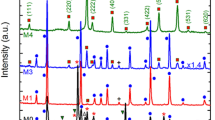Abstract.
Direct synthesis of ZnS nanocrystallites doped with Ti3+ or Ti4+ by precipitation has led to novel photoluminescence properties. Detailed X-ray diffraction (XRD), fluorescence spectrophotometry, UV–vis spectrophotometry and X-ray photoelectron spectroscopy (XPS) analysis reveal the crystal lattice structure, average size, emission spectra, absorption spectra and composition. The average crystallite size doped with different mole ratios, estimated from the Debye–Scherrer formula, is about 2.6±0.2 nm. The nanoparticles can be doped with Ti3+ and Ti4+ during the synthesis without the X-ray diffraction pattern being altered. The strong and stable visible-light emission has been observed from ZnS nanocrystallites doped with Ti3+ (its maximum fluorescence intensity is about twice that of undoped ZnS nanoparticles). However, the fluorescence intensity of the ZnS nanocrystallites doped with Ti4+ is almost the same as that of the undoped ZnS nanoparticles. The emission peak of the undoped sample is at 440–450 nm. The emission spectrum of the doped sample consists of two emission peaks, one at 420–430 nm and the other at 510 nm.
Similar content being viewed by others
Author information
Authors and Affiliations
Additional information
Received: 27 April 2001 / Accepted: 16 August 2001 / Published online: 17 October 2001
Rights and permissions
About this article
Cite this article
Yang, P., Lü, M., Xu, D. et al. Photoluminescence characteristics of ZnS nanocrystallites doped with Ti3+and Ti4+. Appl Phys A 74, 525–528 (2002). https://doi.org/10.1007/s003390101003
Issue Date:
DOI: https://doi.org/10.1007/s003390101003




